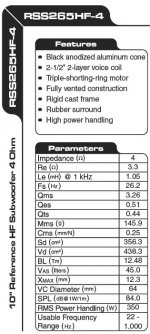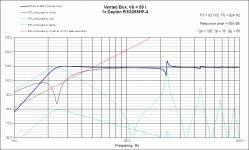Newbie here...
Given a ported enclosure of Vb=59.93L that enables an F(-3) of 23.0 Hz:
And, uses only ONE PORT of:
2.87" inner diameter and 12.84" length (calculated mach <0.16)
Yet EQUIVALENTLY requires:
TWO PORTS of:
2.323" diameter and 17.65" length (mach <0.06) (WHY????)
These values were produced by Box-Port Design II.
I can provide all driver and enclosure specs if you'd like. And, I need to use dual ports for this all front-firing design (the back will be totally against a wall). The driver is a Dayton RSS265HF-4 sub. Front baffle would be 16.0" by 16.0" and by an enclosure depth of whatever needed (aka 14.5" by 14.5" by whatever needed internal space). And, the rear wall would be angled (if that would help to eliminate all standing waves).
I'm just confused about how utilizing dual ports really seems counterintuitive. More should require less internal air volume, right?
Thanks!
Given a ported enclosure of Vb=59.93L that enables an F(-3) of 23.0 Hz:
And, uses only ONE PORT of:
2.87" inner diameter and 12.84" length (calculated mach <0.16)
Yet EQUIVALENTLY requires:
TWO PORTS of:
2.323" diameter and 17.65" length (mach <0.06) (WHY????)
These values were produced by Box-Port Design II.
I can provide all driver and enclosure specs if you'd like. And, I need to use dual ports for this all front-firing design (the back will be totally against a wall). The driver is a Dayton RSS265HF-4 sub. Front baffle would be 16.0" by 16.0" and by an enclosure depth of whatever needed (aka 14.5" by 14.5" by whatever needed internal space). And, the rear wall would be angled (if that would help to eliminate all standing waves).
I'm just confused about how utilizing dual ports really seems counterintuitive. More should require less internal air volume, right?
Thanks!
The bigger the port area, the longer it needs to be to get the same tuning frequncy. a single port with the same overall area as two ports will be the same length. To force the same volume of air through a smaller pipe (in the same amount of time) reqires that it travels quicker.
Tony.
Tony.
The bigger the port area, the longer it needs to be to get the same tuning frequncy. a single port with the same overall area as two ports will be the same length. To force the same volume of air through a smaller pipe (in the same amount of time) reqires that it travels quicker.
Tony.
Thank you Tony for the very quick reply and helping a newbie out.
Please let me borrow your software for a sec which I am certain is better than mine. Attached are graphics of the specs and response (the response I truly like!). Please let me know if you come up with the same dual port specifications that my freeware program did.
Thank you VERY MUCH! This sub driver seems to be what I am looking for. Very low depth, a quite small enclosure, decent volume, etc.
Please let me know what your experienced opinion has to say.
Attachments
I put the params into unibox, (which is what I use and also free). Port length came out a little shorter (16.87") but that was because it was increasing the volume a little.
What power level are you going to drive this at? At 350W you are going to need bigger diameter ports to avoid noise, the problem with that is they are going to be long! I'd go with minimum 3" ports if you are going to drive it at 350W.
If you do that the port resonance comes down and also is bigger, but as this is a sub I assume it won't be going much above 100Hz.
I think that the alignment you have show could be quite boomy. Interestingly unibox suggests that sealed is best for this driver.
Attached graphs show the effect of the port resonance with bigger ports, everything is a tradeoff! crossing over at 80Hz with a steep slope may help with that, but I'm not really experienced with high powered subs so I'm not really sure.
Tony.
What power level are you going to drive this at? At 350W you are going to need bigger diameter ports to avoid noise, the problem with that is they are going to be long! I'd go with minimum 3" ports if you are going to drive it at 350W.
If you do that the port resonance comes down and also is bigger, but as this is a sub I assume it won't be going much above 100Hz.
I think that the alignment you have show could be quite boomy. Interestingly unibox suggests that sealed is best for this driver.
Attached graphs show the effect of the port resonance with bigger ports, everything is a tradeoff! crossing over at 80Hz with a steep slope may help with that, but I'm not really experienced with high powered subs so I'm not really sure.
Tony.
Attachments
That driver can't take 350 w/o significantly exceeding Xmax in that alignment.
At 250 watts it exceeds xmax below ~22Hz. At 350, it exceeds xmax below 40Hz.
2 2.5x20 ports gives a nice flat response w/ F3 22Hz, but gives high port velocity (34 m/s).
Even with 2 4x24 ports, the velocity is quite high (28 m/s). If you want this driver in a vented alignment you will either need large, long ports, live with port noise, or give it less power.
At 100 watts, you still get 104dB and port velocity is more manageable at 22 m/s (2, 2.5x20 ports)
This driver wants to be sealed. A passive radiator is another option.
BTW, F3 isn't perhaps the best spec for judgement. F10 gives a much better idea of in-room performance.
At 250 watts it exceeds xmax below ~22Hz. At 350, it exceeds xmax below 40Hz.
2 2.5x20 ports gives a nice flat response w/ F3 22Hz, but gives high port velocity (34 m/s).
Even with 2 4x24 ports, the velocity is quite high (28 m/s). If you want this driver in a vented alignment you will either need large, long ports, live with port noise, or give it less power.
At 100 watts, you still get 104dB and port velocity is more manageable at 22 m/s (2, 2.5x20 ports)
This driver wants to be sealed. A passive radiator is another option.
BTW, F3 isn't perhaps the best spec for judgement. F10 gives a much better idea of in-room performance.
hello everyone, my first post, didnt want to start a new thread
i'm wondering, what happens to the tuning if you double the box volume and add second identical port ? does the tuning go down, up or stay the same ?
i'm wondering, what happens to the tuning if you double the box volume and add second identical port ? does the tuning go down, up or stay the same ?
No benefits.
If you model the box with one particular "optimal" volume for a given woofer, than doubling that volume (with two vents) will be a disaster.
Download WinISD or Unibox to see what is happening.
If you model the box with one particular "optimal" volume for a given woofer, than doubling that volume (with two vents) will be a disaster.
Download WinISD or Unibox to see what is happening.
the thing is - i'm not modelling for a given driver with known specs
i have 2 cheap 10" subs of aprx. 25 L and my thinking is that pretty much all 10" drivers should easily handle a 50L volume, so i was wondering if maybe there were any benefits to having one driver playing in a bigger volume (by dissambeling and glueing the 2 boxes together)...
i have 2 cheap 10" subs of aprx. 25 L and my thinking is that pretty much all 10" drivers should easily handle a 50L volume, so i was wondering if maybe there were any benefits to having one driver playing in a bigger volume (by dissambeling and glueing the 2 boxes together)...
- Status
- Not open for further replies.
- Home
- Loudspeakers
- Subwoofers
- One Port versus Two Ports Question



